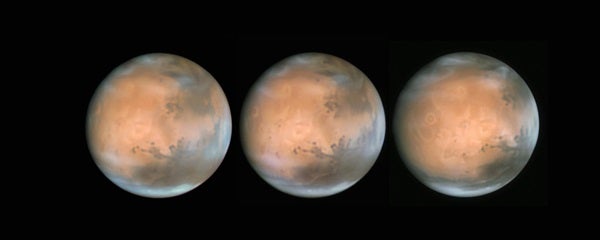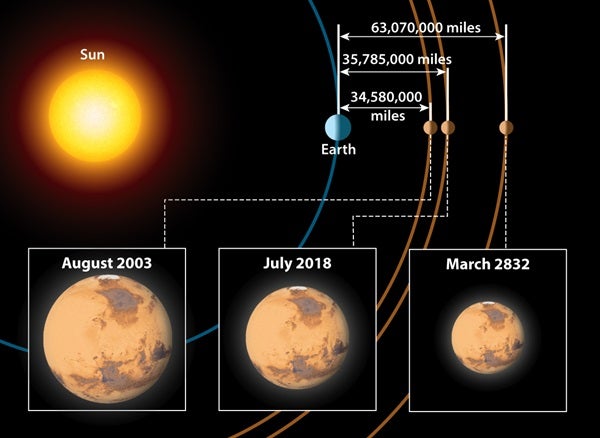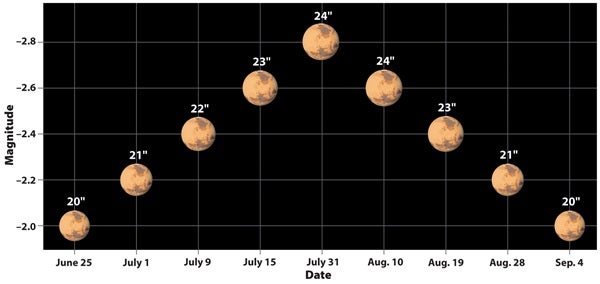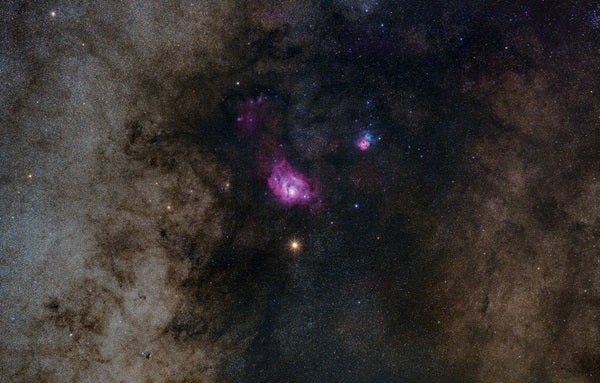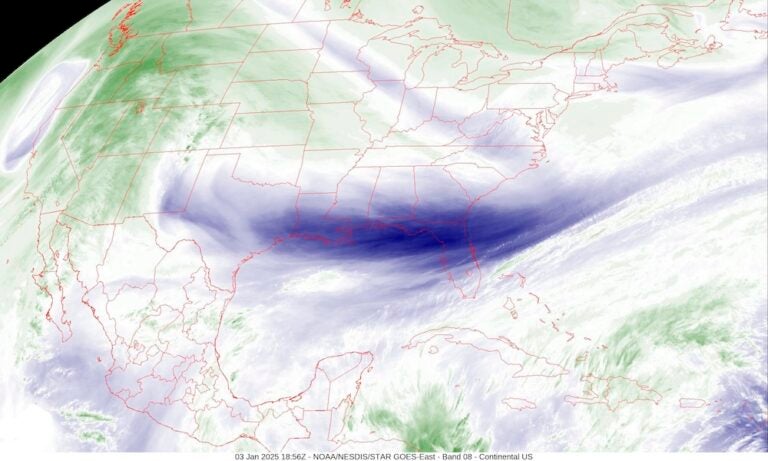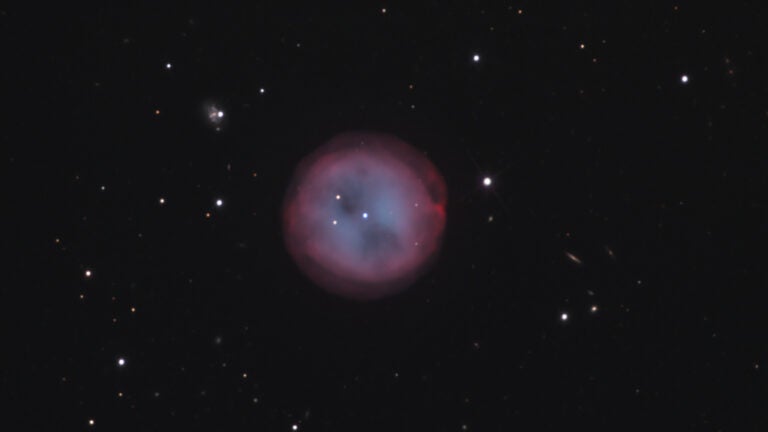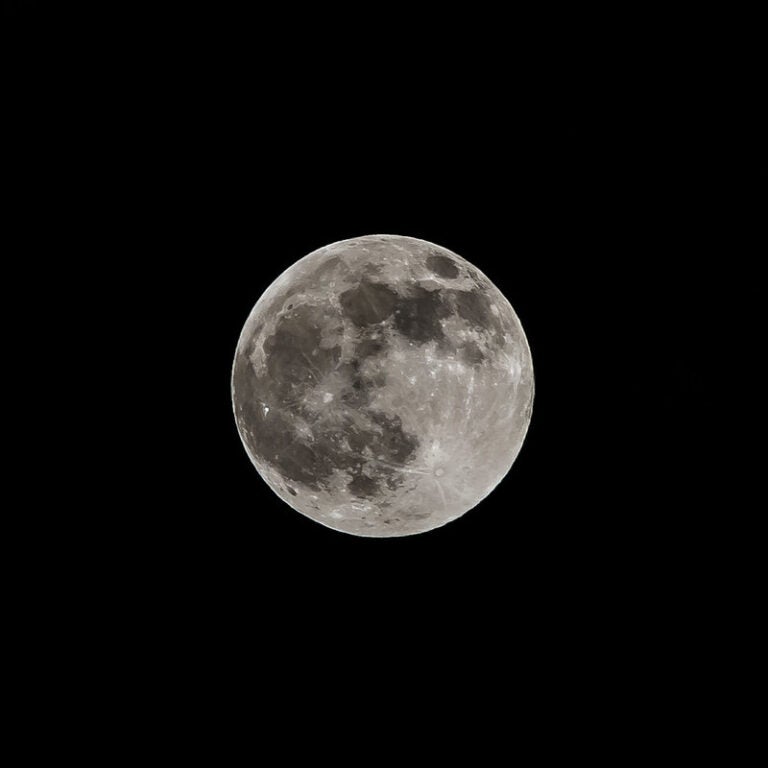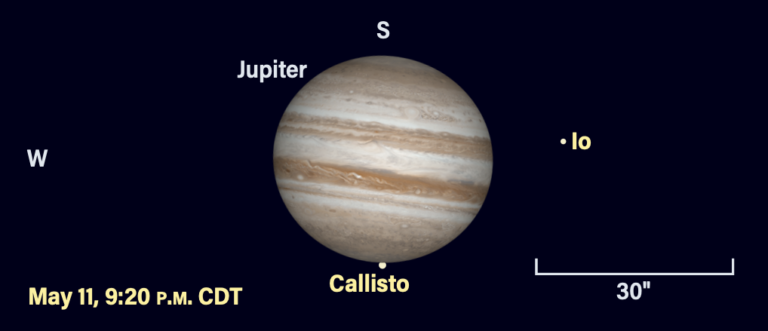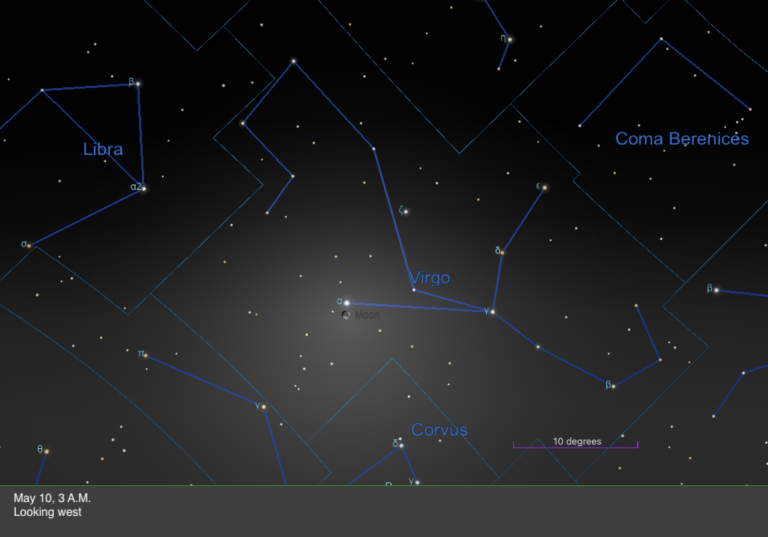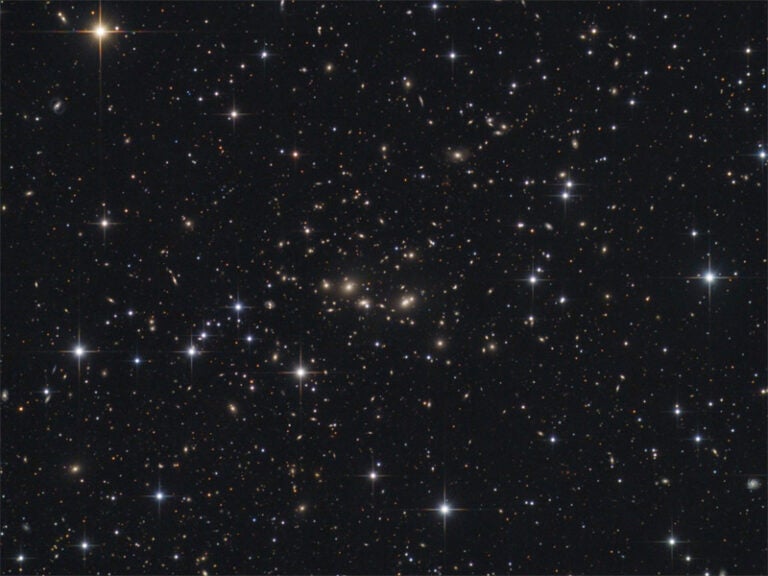Planetary observing hits a high point this summer as Mars dominates the evening sky. Dust off your scope, because this is the year to observe the Red Planet. It hasn’t been this big and bright since 2003, and it won’t be again until September 2035.
So, excitement is building. For readers new to Red Planet mania, astronomers’ interest peaks during times called oppositions, when Mars lies opposite the Sun from our perspective on Earth. This year’s opposition occurs July 26 or 27, depending on where you live. Let me explain.
Although a bit farther and smaller than it appeared in 2003, Mars in 2018 will appear much larger than during its worst opposition, more than 800 years from now.
The moment of opposition occurs at 5h13m Universal Time on the 27th. In the United States, that’s 1:13 a.m. EDT. If you observe from the Mountain or Pacific time zones, the date of opposition will be the 26th.
Then, a scant four days later, Mars reaches its closest point to Earth. An opposition happens every 780 days (minus 1 hour 26 minutes 24 seconds, to be exact). But each closest approach to Earth is not really, well, closest because Earth’s and Mars’ orbits are not circular, so the distance between our two worlds changes from one opposition to the next.
During a distant opposition, Mars can lie more than 60 million miles (97 million kilometers) away. Contrast that with a nearby opposition that places Mars less than 35 million miles (56 million km) from Earth.
For observing purposes, it all comes down to apparent diameter. Astronomers use angular measurement to describe how large a celestial object appears. A planet’s angular size can change a lot. Mars varies in size at opposition from a minimum of 13.8″ to a maximum of 25.1″. And its maximum brightness at each close approach varies from magnitude –1.5 to –3.0.
In 2018, opposition occurs July 27, but Mars lies closest to Earth (and thus appears a smidge larger) on the 31st. The Red Planet will lie 35,785,000 miles (57,590,000 km) away then. It will span 24.33″ and shine at magnitude –2.8. And — not that you’ll need any stars to locate it — its position will lie within the constellation Capricornus just north of the midpoint of a line joining the magnitude 4.7 star 62 Sagittarii (HIP 98688) with magnitude 4.3 Omega Capricorni.
How big and bright Mars appears depends on when you observe it. This graph shows how the Red Planet’s apparent size grows before opposition and shrinks afterward.
Observers at northern latitudes find themselves at a severe disadvantage this summer. At opposition, Mars’ declination (distance above or below the celestial equator) is –25°34′. This means for an observer at 40° north latitude, Mars will climb a scant 24° above the southern horizon at midnight local time.
It’s important to consider a planet’s altitude because the less air you view (or photograph) through, the better the image. So, if you have a choice, head south. Even a 10° change in latitude will let you see more surface details. Ideally, we all probably want to observe from latitude 25°34′ south. Anyone up for a trip to Brisbane, Australia? At midnight there, Mars will be overhead on its opposition date.
Here’s a tip: Don’t wait for opposition. Although the Red Planet will be biggest and brightest around the end of July, Mars will really put on a show for more than a month on either side of opposition.
The darkness of your site doesn’t matter much. Indeed, some ambient light actually is welcome when you observe the Red Planet. A white light off to your side (not directly in your field of view) lighting up your surroundings will cause your daytime vision — which is superior to night vision in both resolution and color sensitivity — to kick in.
Want to observe from a parking lot in Chicago? If it’s clear, you’ll see some detail, even through small telescopes. But you shouldn’t observe from a parking lot because the steadiness of the air above your site — what astronomers call seeing — makes all the difference. The better the seeing, the more detail your scope will reveal. Unfortunately, any parking lot stores lots of daytime heat in the summer and releases it at night, ruining the view of even bright objects like Mars. So leave the city behind.
Albedo features are the areas most subject to seasonal changes such as brightening or darkening. Through a 4-inch or larger telescope, you’ll see large albedo features — regions distinguished by the amount of light they reflect. Mars’ best include Syrtis Major (an easily seen dark, triangular feature), Chryse, Elysium, the Hellas Basin, Libya, and Solis Lacus.
Mars’ day, which astronomers call a sol, is 37.4 minutes longer than an Earth day. So, if you observe Mars at the same time each night, its markings will appear to move 9.11° per day to the west. In a little more than five weeks, the planet seems to slowly rotate backward one full spin. All of Mars’ prominent features will, at some time during this period, lie on its meridian, the line splitting the planet’s visible disk from top to bottom, as seen from Earth. All martian features look their best when on the planet’s meridian.
Even including albedo highlights, the Red Planet’s best surface features are its polar ice caps. At opposition, Mars’ south polar cap will tilt 11° in our direction.
Due to the temperature range at the martian poles, astronomers subdivide each ice cap into larger “seasonal” and smaller “residual” caps. Residual caps last through the martian year. The southern residual ice cap measures about 200 miles (320 km) across. The northern residual ice cap spans about 600 miles (960 km).
Winters are more severe in Mars’ northern hemisphere, and the seasonal ice cap there has reached a latitude of 45°. In the southern hemisphere, the seasonal ice cap never passes above a latitude of about –55°.
Don’t confuse the Hellas Basin with the polar cap. Hellas is a round, bright feature — an impact basin with lots of bright dust and sometimes fog or clouds. When seen near the limb (the planet’s edge), it can look like a polar cap.
With respect to clouds, all of them on Mars are temporary. Discrete clouds associate with a specific area, and Mars’ rotation carries them along.
Orographic clouds are a type of discrete cloud. Wind passing over high mountains and volcanoes creates these water-vapor clouds. Observe orographic clouds through a blue or violet filter to see the most contrast.
Look away from Mars’ meridian and observe morning and evening clouds. These bright, isolated patches of surface fog appear at sunrise (the western edge of Mars) and sunset. Evening clouds generally appear larger and are more numerous, and as the martian night approaches, they grow larger. These clouds respond best to blue or violet filters.
Color filters show a lot when you observe Mars, but they do take some getting used to. Be patient, and you’ll be amazed at how much more detail you’ll see.
Although Mars will appear biggest July 31, it will look almost as bright several weeks before and after that date. So, if you’re clouded out, or if the 31st just doesn’t work for observing, cheer up. Unlike totality during a solar eclipse, a martian opposition isn’t a short-lived event.
Just keep in mind that the best time to observe Mars is any night it’s in the sky. Once every 26 months, Mars appears bright in our sky, but some of these appearances — like this one — are better than others. Take advantage of the planet’s size and brightness, and don’t worry so much that it’s so low in the sky. Head out to a science center or observatory, contact your local astronomy club, or simply point your scope at the Red Planet. Then focus and take a good, long look.
A version of this story ran in Astronomy’s May issue.

